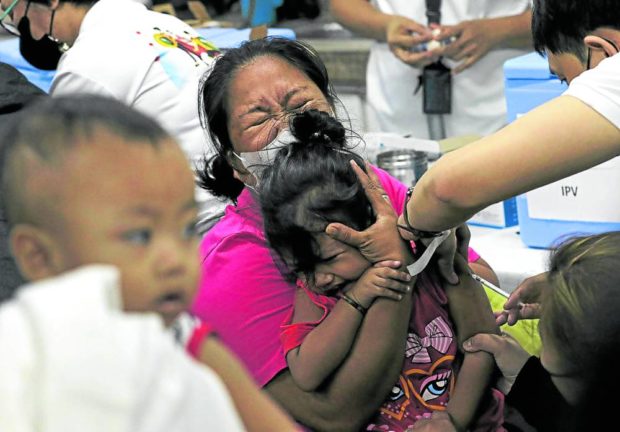WHO: Measles emerging global threat

VAX-BABY-VAX A mother feels for her baby girl during the Department of Health’s catch-up jab program in Taguig City on Nov. 7. —RICHARD A. REYES
There is now an imminent threat of measles spreading in various regions globally, as COVID-19 led to a steady decline in vaccination coverage and weakened surveillance of the disease, the World Health Organization (WHO) and the US public health agency said on Wednesday.
A record high of nearly 40 million children missed a measles vaccine dose in 2021 due to hurdles created by the COVID pandemic, the WHO and the US Centers for Disease Control and Prevention said in a joint report.
“We are at a crossroads,” American physician Patrick O’Connor, WHO’s focal person on measles, said on Tuesday. “It is going to be a very challenging 12-24 months trying to mitigate this.”
A combination of factors like lingering social distancing measures and cyclical nature of measles may explain why there has not yet been a global explosion of cases, but there have been large disruptive outbreaks since the start of 2022, rising from 19 to almost 30 by September, O’Connor said.
PH cases still rising
In the Philippines, Health Undersecretary Maria Rosario Vergeire, officer in charge of the Department of Health (DOH), warned last month that the country may again face a measles outbreak by 2023.
“There might be an impending outbreak of measles in the country by next year if we are not going to do anything,” Vergeire said, adding that the WHO had already warned the government about the 3 million children nationwide who have not been vaccinated against measles.
203% increase
In its latest Measles Surveillance Report, the DOH said there are already 467 measles cases reported from Jan. 1 to Oct. 8, 203 percent higher than the 154 measles cases reported during the same period in 2021.
The report said the Calabarzon region had the most number of cases with 84, followed by Central Visayas with 63 and National Capital Region with 53.
But all 17 regions of the country are considered at high risk of measles outbreaks that usually occur every four to five years, with the last one taking place in 2018 and 2019, according to DOH Epidemiology Bureau Director Alethea de Guzman.
Due to low jab rate
De Guzman concurred that this is mainly because of the low immunization rate seen among children over the recent years.
Measles is one of the most contagious human viruses and is almost entirely preventable through vaccination. However, it requires 95-percent vaccine coverage to prevent outbreaks among populations.
—Reports from REUTERS and the INQUIRER STAFF
RELATED STORY:
Measles now an imminent global threat due to pandemic, say WHO and CDC